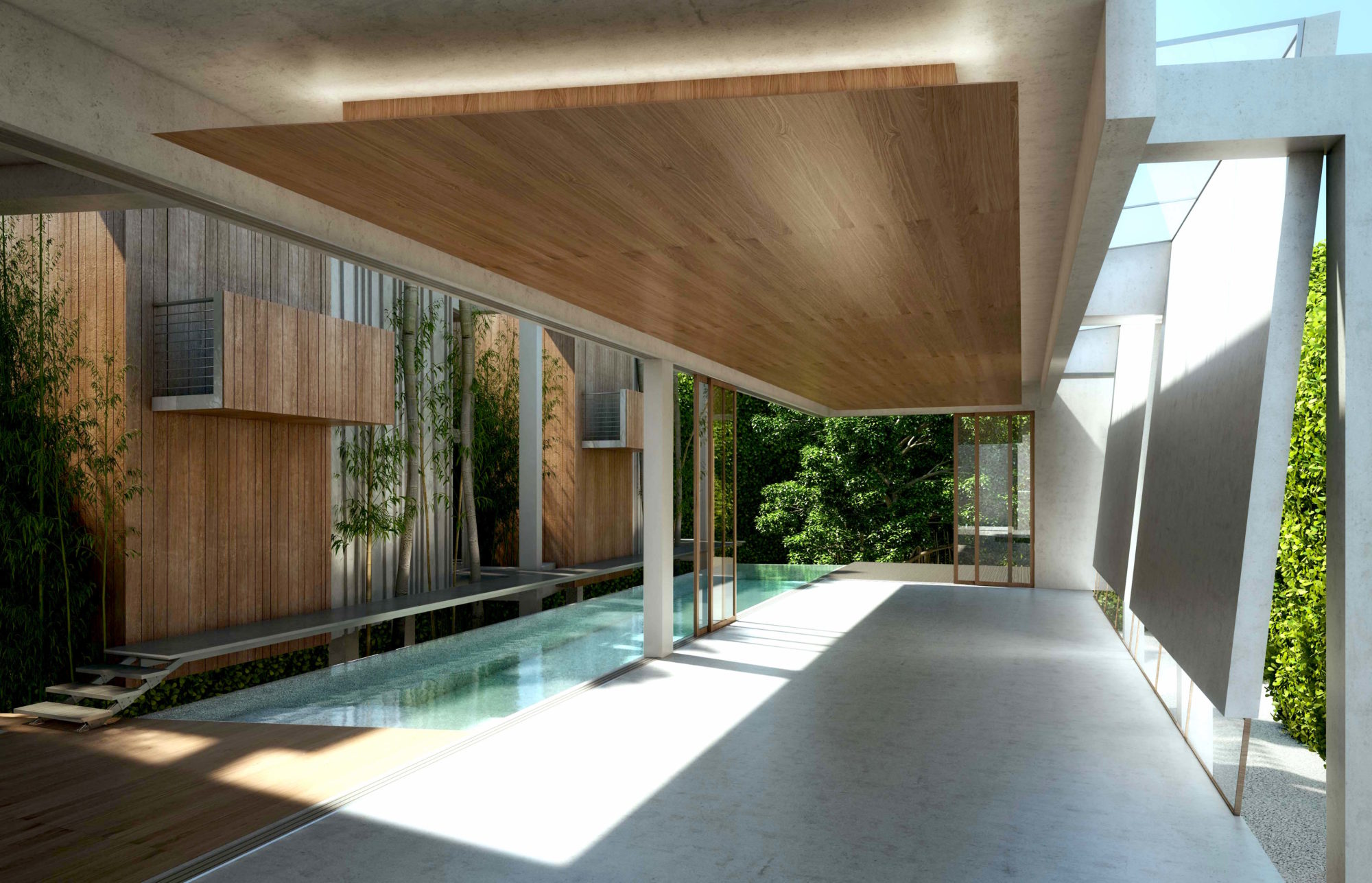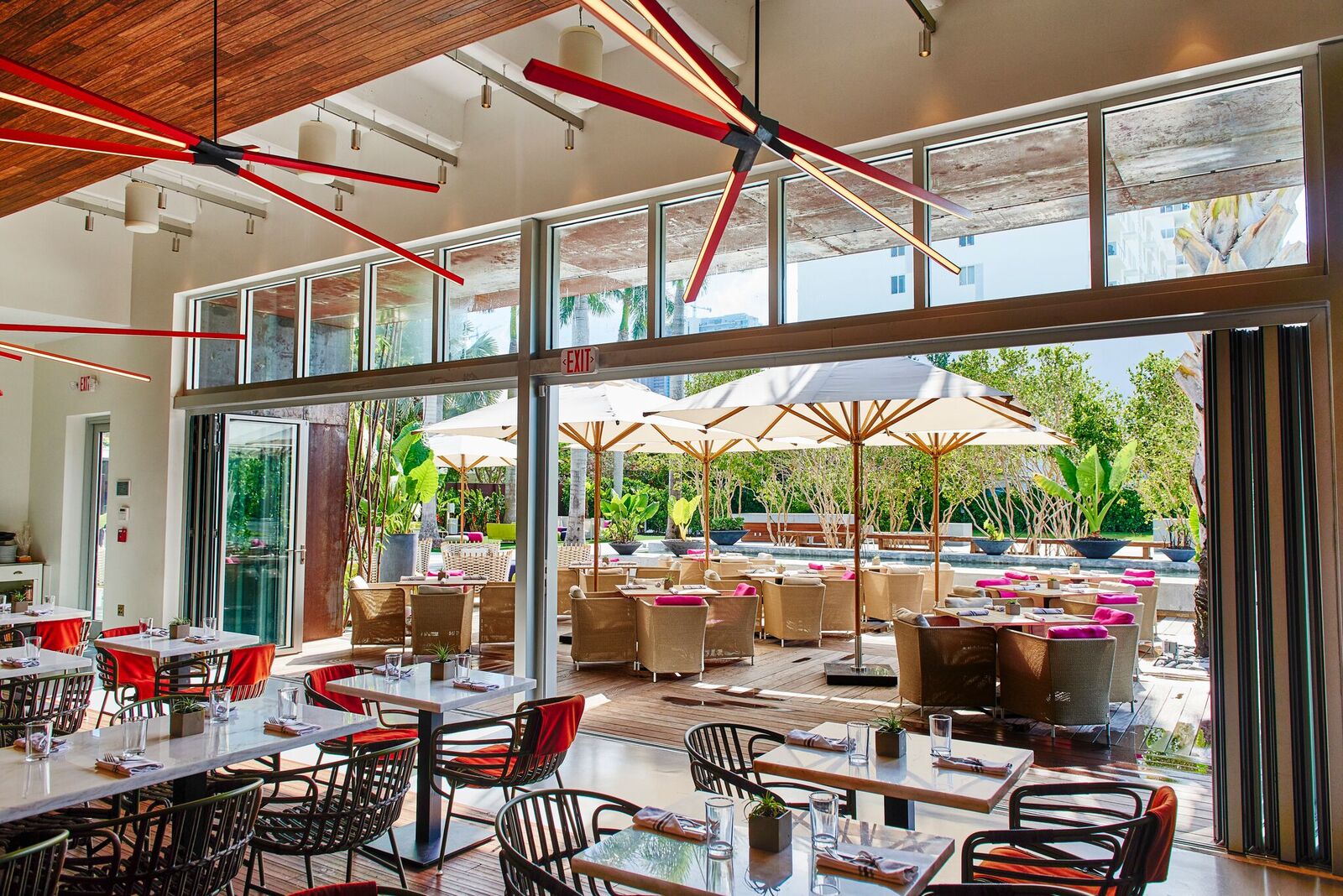It’s a postcard-picture December afternoon in the Miami Beach Botanical Garden. Butterflies flit between tall purple orchids and stalks of bamboo. Baby turtles in ponds float past lily pads in no particular hurry. At the garden café, lunch service is in full swing. Rene Gonzalez sends me a text message. He’s running late, which is to be expected during the frenetic week of Art Basel.
Having publicly unveiled his new Prairie Avenue house the day prior, the architect and his eponymous firm, Rene Gonzalez Architect (RGA), are attracting much attention. Designed as an elongated, horizontal series of pavilions elevated on stilts, the structure appears to be an assemblage of floating walls made chiefly of exposed concrete. At once striking and serene, the museum-like beach house appears to defy gravity.
Standout projects like this—including a sensuous, resortlike home on Indian Creek Island; a light, ethereal condo tower called Glass on the southern tip of Miami Beach; and a tropical garden oasis known simply as South Florida Residence—have built Gonzalez’s reputation as the go-to architect for Miami’s most inventive modern residences. Along with these, RGA is also well known for its spare and environmentally conscious public projects, most recently Miami’s Plant Food + Wine restaurant.
Arriving with iPhone in hand, Gonzalez is wearing designer sunglasses, a steel gray button-down shirt, and faux-leather jeans with brass-zippered pockets. At 53, he’s easygoing and gregarious, but dead serious when it comes to his work. Before he can reach the table, three fawning friends stop to greet him, and offer praise for the Prairie Avenue house.
Just a few days prior, Fidel Castro had died. I wanted to know his thoughts about it. It seemed the right place to begin an interview with him. In hindsight, it was the closest I would come to understanding Gonzalez’s inner life. Below, an excerpt of our conversation.
You were born in Cuba. How do you feel about Fidel’s passing?
My family went through some difficult times. It’s the typical Cuban story. We all got split up. I was three years old at the time, so I didn’t know what happened. My grandfather was a political prisoner. My godmother was a “Peter Pan child,” which means her parents sent her off to live with a family, not knowing whether they’d see her again, just to get her out of the country. Properties were taken over by the government. When I heard the news of Fidel dying, I was texting with a very close friend who lives in London. He said, “This morning, I sobbed, and I thought—I want to go home, wherever the fuck that is.” That’s the only thing that I carry with me. That I’ve never been able to feel the place where I was born.
As an architect, you build homes for others. Does this longing color your work?
Definitely. I appreciate the urban fabric of Havana. I spent a great deal of time trying to understand my home country. Eventually, I taught a class on Cuban architecture at Florida International University. I often find a place in my projects for Cuban elements—but I present them in a way that’s new and fresh and consistent with the specifics of the site. I’ve never been interested in recreating architectural typologies. I’m very interested in cultural conditions. Havana homes are all about porous layers between urban and suburban life. For instance, a colonial house will come right up to the sidewalk—you want to create a layer of privacy. They use persianas (louvers) that can open or close, allowing breezes and light to come through. Courtyards are another way of layering, which is in my DNA.
What was your first big break in the profession?
I went to Los Angeles, to go to school at UCLA. There was a lot of experimentation going on there in the late ’80s—breaking the boundaries in interesting ways between interiors and exteriors. Michael Palladino [principal designer of Richard Meier & Partners] became my thesis advisor. When he read my thesis about a monastery in the Florida Keys, he asked me to come work for him. [Soon after, Gonzalez served as project designer with Richard Meier & Partners on the Getty Museum in Los Angeles.] That was it. For me, it’s always been very clear what I want to do. My life and work are one in the same. I don’t make a distinction between them.
Who do you consider your most important mentor?
I had an architecture professor named Eugene Kupper. He came from a school of thought where you accept happy accidents. He allowed me to realize that I could use my intuition, much more than I had been doing. To think about how work can be transformed in a positive way, if you see obstacles as opportunities. At first, it was too loosey-goosey for me. I’m very disciplined in the way that I work. But eventually, I learned to how to see the value in problems.
Do you have an example in mind?
Sure. Take the Prairie house, which is elevated on 10-foot stilts. You experience the ground plane from the first floor. The concrete walls are literally suspended in air by steel brackets. The suspension makes them appear light, as if they are floating. All of this is meant to address the environmental obstacles of coastal erosion, storm surges, and rising sea levels. We also created undulating gardens on the ground plane that retain water when it rains. That’s what I mean by an opportunity. How can we deal with drainage? We find a poetic way to deal with it.
What’s next for you?
I’m a bit consumed right now, building my home on Belle Isle, a barrier island in the middle of Biscayne Bay. It, too, is elevated on stilts. Apart from that, I’m very interested in creating impactful experiences in other parts of the world. We’re taking on projects in China. Of course, I’d love to build in Cuba. Especially if it’s under a government that acknowledges human rights and freedoms.
Gonzalez documents Cuban architecture in an upcoming book about his work, Not Lost in Translation, to be published in 2018 by The Monacelli Press. A version of this article appears in the spring/summer 2017 issue of Centre, a semiannual magazine produced by Surface Studios.


